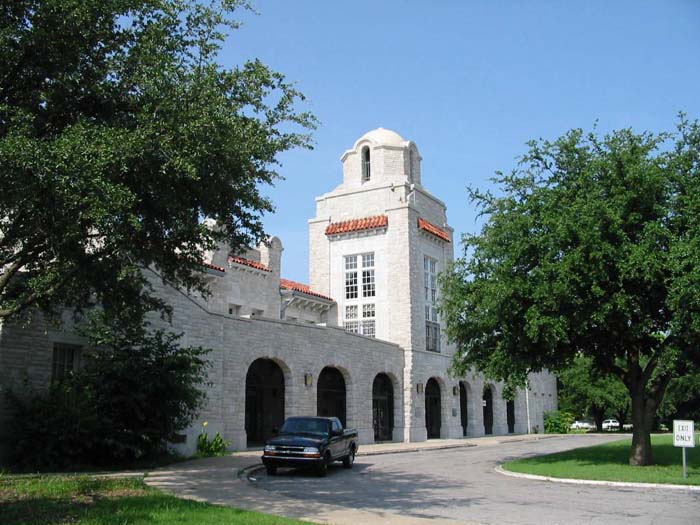- Union Depot (Oklahoma City)
name=Union Depot
address=300 Southwest 7th Street
Oklahoma City, OK
code=
owned=Central Oklahoma Parking and Transit Authority
line=
other=COTPA offices
passengers=|pass_year=|pass_percent=Location
300 S.W. 7th Street, Oklahoma City, Oklahoma 73109
History
Oklahoma City Union Station, opened in
1931 , was built to move surface rail lines and two separate rail company depots out of downtown Oklahoma City. Rail traffic was so dense at the time that it was reportedly hard to get a fire truck across downtown. Grade separating the rail lines and streets was the critical issue forOklahoma City business and downtown growth. The Rock Island and Frisco railroad companies consolidated their station operations at the new Union Station. The depot closed to the public in 1967 following the discontinuance of the last Frisco passenger train servingOklahoma City . In the 1980's the station & the depot was purchased by the city ofOklahoma City to become amultimodal transportation center at a cost of $1.8 million with $1.2 million being an FTA grant for the sole purpose of using Union Station for mass transit. Oklahoma City has slated the removal of the station south of Union Station leaving only the depot behind. This realignment is currently being challenged by several organizations (OnTrac, North American Transportation Institute, Common Cause to name a few) have combined efforts to preserve these rail lines for rail transit. This realignment will add an additional 10 lanes of road through downtown Oklahoma City while the current corridor becomes a major thorough fare becoming 16 lanes total. Oklahoma will spend roughly $1 billion on the project with hopes of completing in 2012. On 6/5/2008 the STB stated that BNSF falsified an application and ruled against the realignment [AB_6_430_X [http://stb.dot.gov/decisions/readingroom.nsf/51d7c65c6f78e79385256541007f0580/b2e02629dbdb0c5f8525745e005bf812?OpenDocument] ] . BNSF filed a petition to bypass hearings and debate all together to force the realignment [FD_35164_0 [http://www.stb.dot.gov/filings/all.nsf/6084f194b67ca1c4852567d9005751dc/c725d14cf3ba34f385257487005b5cd5?OpenDocument] ] . Dr. Kessler's original docket showing fraud can be found here. [AB_6_430_X [http://stb.dot.gov/filings/all.nsf/6084f194b67ca1c4852567d9005751dc/ef658a7adee2812585257428005b0bb7?OpenDocument] ] .Architecture
The terminal building, with 55,000 square feet on its main floor, is a sprawling, generous California Spanish
Mission Revival style. The structure included many elegant touches (small courtyards and alcoves with fountains and gardens surrounding the station terminal).tation Facilities
Passengers accessed the 12-track station through subterranean tunnels "via" a gentle ramp from the grand waiting room at the depot. Mail and express were also routed under the station to the surface passenger platforms. Hudson and Harvey street traffic met the trains "at grade," enabling easy passenger access and seamless exchange of time-sensitive mail and express freight between trucks and trains. Arterial traffic on Robinson and Walker streets flowed freely under rail yard underpasses built as an integral part of the station complex. Massive freight warehouses and material handling areas were located behind the passenger facilities. This station can be used for mulitmodal transportation including light rail, Amtrak, and city busing thus making it multimodal.
trategic Location: Oklahoma City Carriers
Union Station served and still serves as the center of Oklahoma's rail lines.
*The Rock Island's east-west Memphis and Tucumcari route hosted several passenger trains, including the
Choctaw Rocket andTwin Star Rocket connection throughout the years.*The Frisco railroad operated trains such as the Meteor, Oklahoman, Firefly, and Will Rogers all through Tulsa. Additional, lesser know passenger extensions operated between
Oklahoma City and Lawton.*Direct connection was made with the Katy railroad just northeast of Union Station in the warehouse district. The Katy, along with tenant railroad, Oklahoma City Ada and Atoka (OCAA), operated a passenger depot in the warehouse district. The Katy route operated between
Oklahoma City andParsons, Kansas . The OCAA operated limited passenger rail doodlebug service to the southeast Oklahoma community of Atoka.*The
Atchison, Topeka and Santa Fe Railway , nowBNSF , north south Texas mainline elevated tracks are accessed to the east of the station. Many large Oklahoma communities such as Ponca City, Guthrie, and Edmond (to the north of Oklahoma City) and Moore, Norman, Purcell, and Ardmore (to the south of Union Station) are located on the longer Chicago to Houston BNSF route. The portion south ofOklahoma City serves asAmtrak 'sHeartland Flyer route. TheHeartland Flyer however stops at the privately owned Santa Fe depot.Current Passenger Services
Bus None
Rail None
Business
Central Oklahoma Parking and Transit Authority (COPTA) offices.References
* [http://www.advancedtransport.org/Articles/1124.htm North American Transportation Institute]
External links
* [http://nomoron.com/UnionStation.html Oklahoma City Union Station (with photographs and drawings)]
* [http://members.aol.com/sfrr5/history/upexc.htm 1995 Central Oklahoma Railfan Club Union Pacific Excursion]
Wikimedia Foundation. 2010.

